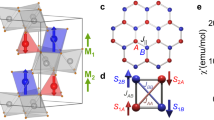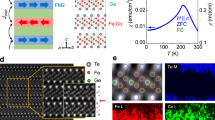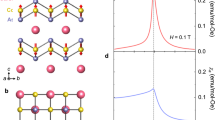Abstract
The total energy of a magnet in a magnetic field is lowest when the magnetic moment is aligned parallel to the magnetic field. Once aligned, the magnetic moment can be reversed by applying a sufficiently large field in the opposite direction. These properties form the basis of most magnetic recording and storage devices. But the phenomenon of magnetization reversal in response to a change in temperature (in a small magnetic field) is rarer. This effect occurs in some ferrimagnetic materials consisting of two or more types of antiferromagnetically ordered magnetic ions1, and forms the operational basis of ferrimagnetic insulators. Here we report the observation of multiple temperature-induced magnetization reversals in YVO3. The net magnetic moment is caused by a tilting of the antiferromagnetically aligned moments of (crystallographically identical) V3+ ions, due to orthorhombic distortion in the crystal structure. We observe an abrupt switching at 77 K associated with a first-order structural phase transition, and a gradual reversal at ∼95 K without an accompanying structural change. The magnetization always reverses if the crystal is cooled or warmed through these two temperatures in modest fields. We propose a possible mechanism involving a change in orbital ordering which may be generic to a broad class of transition metal oxides.
This is a preview of subscription content, access via your institution
Access options
Subscribe to this journal
Receive 51 print issues and online access
$199.00 per year
only $3.90 per issue
Buy this article
- Purchase on Springer Link
- Instant access to full article PDF
Prices may be subject to local taxes which are calculated during checkout




Similar content being viewed by others
References
Menyuk, N., Dwight, K. & Wickham, D. G. Magnetisation reversal and asymmetry in cobalt vanadate (IV). Phys. Rev. Lett. 4, 119–120 (1960).
Goodenough, J. B. Metallic oxides. Prog. Solid State Chem. 5, 145–399 (1973).
Khomskii, D. I. & Sawatzky, G. A. Interplay between spin, charge and orbital degrees of freedom in magnetic oxides. Solid State Commun. 102, 87–99 (1997).
Shirakawa, N. & Ishikawa, M. Anomalous diamagnetism of a peroviskite LaVO3. Jpn Appl. Phys. 30, L755–L756 (1991).
Mahajan, A. V., Johnston, D. C., Torgeson, D. R. & Borsa, F. Magnetic properties of LaVO3. Phys. Rev. B 46, 10966–10972 (1992).
Goodenough, J. B. & Nguyen, H. C. The peculiar ferromagnetism of LaVO3. C.R. Acad. Sci., Paris 319, 1285–1291 (1994).
Nguyen, H. C. & Goodenough, J. B. Magnetic studies of some orthovanadates. Phys. Rev. B 52, 324–334 (1995).
Nguyen, H. & Goodenough, J. B. Magnetic and transport properties of CeVO3. J. Solid State Chem. 119, 24–35 (1995).
Corti, M., Cintolesi, A., Lascialfari, A., Rigamonti, A. & Rossetti, G. Magnetic properties of YVO3from susceptibility and 89Y NMR measurements. J. Appl. Phys. 81, 5286–5288 (1997).
Zubkov, V. G., Bazuev, G. V. & Shveikin, G. P. Low-temperature neutron- and X-ray-diffraction investigations of rare-earth orthovanadites. Sov. Phys. Solid State 18, 1165–1166 (1976).
Kawano, H., Yoshizawa, H. & Ueda, Y. Magnetic behavior of a Mott-insulator YVO3. J. Phys. Soc. Jpn 63, 2857–2861 (1995).
Bertaut, E. F. in Magnetism Vol. III(eds Rado, G. T. & Suhl, H.) 86–126 (Academic, New York and London, (1963)).
Borukhovich, A. S., Bazuev, G. V. & Shveikin, G. P. Anomalies of the specific heat and magnetic thermodynamic parameters of yttrium orthovanadite. Sov. Phys. Solid State 16, 191–192 (1974).
Goodenough, J. B. Magnetism and the Chemical bond (Interscience, New York–London, (1963)).
Sawada, H., Hamada, N., Terakura, K. & Asada, T. Orbital and spin orderings in YVO3and LaVO3in the general gradient approximation. Phys. Rev. B 53, 12742–12749 (1996).
Acknowledgements
We thank J. B. Goodenough for discussion of the results and for explaining his ideas on the origin of the magnetization reversal in LaVO3; we also thank J. Rodriquez-Carvajal and E. F. Bertaut for discussion. This work is supported by the Netherlands Foundation for the Fundamental Research of Matter (FOM) and the Dutch Organization for the Advancement of Pure Research (NWO), and in part by EU (OXSEN).
Author information
Authors and Affiliations
Rights and permissions
About this article
Cite this article
Ren, Y., Palstra, T., Khomskii, D. et al. Temperature-induced magnetization reversal in a YVO3 single crystal. Nature 396, 441–444 (1998). https://doi.org/10.1038/24802
Received:
Accepted:
Issue Date:
DOI: https://doi.org/10.1038/24802
This article is cited by
-
Transient polymorphisms in parental care strategies drive divergence of sex roles
Nature Communications (2023)
-
Negative Magnetization Effect in Distorted Honeycomb Ni4Nb2O9 Ceramics
Journal of Low Temperature Physics (2022)
-
Coexistence of ferromagnetism, antiferromagnetism, and superconductivity in magnetically anisotropic (Eu,La)FeAs2
npj Quantum Materials (2021)
-
Negative Magnetization and Superconductivity in the (LaPt2Asx (x = 1, 2) and BaPt2As2 Compounds
Journal of Superconductivity and Novel Magnetism (2021)
-
Nucleation and growth of orbital ordering
Nature Communications (2020)
Comments
By submitting a comment you agree to abide by our Terms and Community Guidelines. If you find something abusive or that does not comply with our terms or guidelines please flag it as inappropriate.



